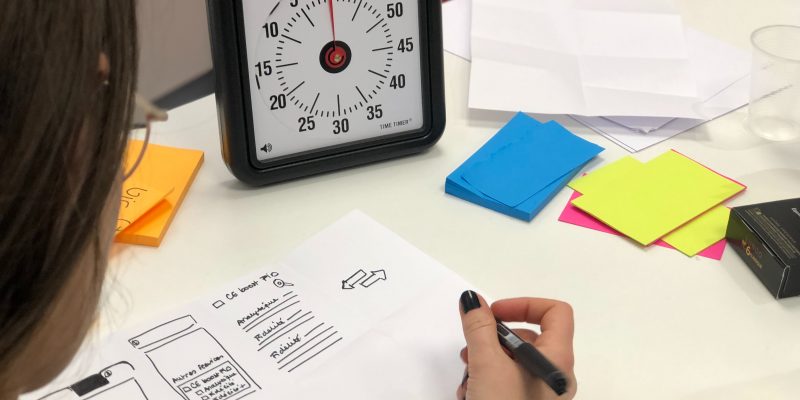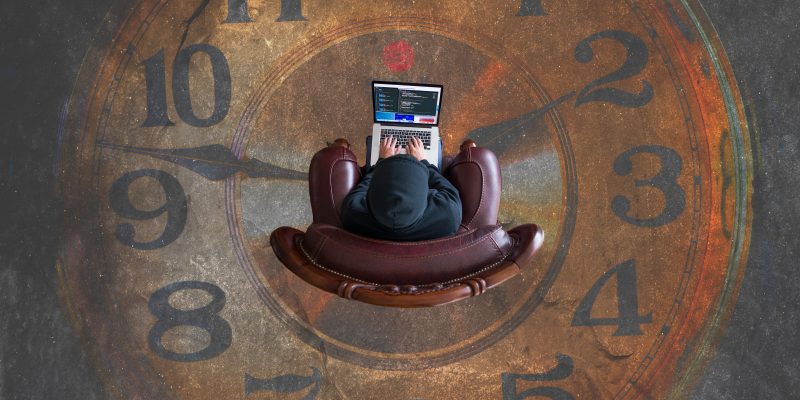(Reclaim Your Time and Sanity in a Remote Working World)
This article was originally posted on the Optimize Yourself website which is a coaching and mentorship program that helps creative professionals do better and be better, founded by Zack Arnold.
Debby Germino is the content producer and a coach for Optimize Yourself and she and I connected when I was offering my Productivity Through Presence course. We quickly discovered the synergy between the Optimize Yourself coaching program and my own Optima Results program (I mean the names say it all, right?). After having a great conversation with Zack on the Optimize Yourself podcast about aligning your values with your time, I thought this article would be valuable to share here.
I don’t know about you, but my brain is like an endless news ticker reminding me of the growing tasks, activities, ambitions, and must-do’s that I need to accomplish to prove my worth as a human. No sooner do I start one checklist item and I’m already thinking of the next. It’s been ingrained in me that striving, achieving, and accomplishing must be happening at all times!
No longer are we human beings. We have become a society of human doers. We glorify those who do it all. Our hailed celebrities aren’t famous for doing one thing. They are famous for doing a bunch of things.
If you look at Oprah Winfrey’s Wikipedia page, it says she’s an,
“American talk show host, television producer, actress, author, and philanthropist.”
They left out magazine publisher, network owner, and Emmy AND Oscar award winner.
We see this in the entertainment industry all the time: Editors are becoming directors, directors are becoming producers. Actors write, direct, and produce. There is no end to the skills and abilities we should add to our list of credentials.
And that’s just our careers. If we want a family, a social life, and a healthy body and mind, the time required to maintain these things is often in great conflict with our career demands. Even during a pandemic, with commuting being taken out of the equation (for many), we are still rushing around getting the household chores done, making sure kids and pets are settled, all while trying to make it to the next Zoom meeting on time. We’ve lost all boundaries between work and home life.
There is a perpetual OPEN sign hanging on our computers that taunts us all hours of the day inducing guilt if we ignore it, and burnout if we obey it.
Many of us are facing career transitions (either voluntary or involuntary) and the options of where to focus our time and energy are overwhelming at best and debilitating at worst. We should update our resumes, revamp our portfolio websites, reconnect with contacts, reach out to new contacts, but not before researching thoroughly the exact right person that can help us with our next career move. Oh, and that doesn’t even cover the technical skills we should brush up on or the interview skills we should polish.
Ugh!
My head is spinning just writing all of this.
One thing I’ve learned in over a decade of mindfulness training is that when there is overwhelm, it is helpful to name it. Having a term for what we are experiencing normalizes it and creates space around it so it’s not so constricting.
The name for this crazy, incessant pressure we feel is “Time Famine.”
It’s a real thing, and thankfully there are ways we can reduce it (that don’t involve cutting your sleep to 4 hours a night).
“Time Famine” is stealing your happiness…but there is hope.
The term ‘Time Famine’ was coined by researchers in 1999 and is defined as “a feeling of having too much to do and not enough time to do it.” That pretty much describes the feeling I’ve had my whole adult life. I’m encouraged to know I’m not alone.
The Forbes article, Is Time Famine Starving You? How To Satisfy Your Hunger For More reports that:
“… 66% of wage earners say they don’t have enough time to be with their children and spouses or to spend on themselves.”
And it turns out this feeling of time famine does not bode well for our mental health. Researcher and author Ashley Whillans, wrote a book titled Time Smart, on the research she conducted and her findings show that people who feel time famine:
- experience lower levels of happiness and higher levels of anxiety and depression
- experience less joy and more stress
- laugh less
- they exercise less and are less healthy
- their productivity at work is diminished
- they are less likely to help others
- they lose sight of what’s truly important to them
I can attest to many of these results when I feel overwhelmed and strapped for time.
So what do we do about this?
Hope for a time-making machine so we can have 32 hour days?
Parkinson’s Law states “work expands to fill the time available for its completion.” To put it simply, this tells us that longer days would not solve our problem. Luckily, we don’t need a time machine to reduce time famine. All that is required are three simple practices that will help calm the mind and increase your happiness:
- Align your values with your time using the “ABC’s of Meaning” framework
- Practice ‘being’ over ‘doing’ with mindfulness practices
- Create a ‘Time Windfall List’ so you have healthier ways to spend pockets of time when you’d otherwise waste it
1. Focus on ‘Doing’ things that fulfill you (using the ABC’s of Meaning)
For centuries humans have been contemplating the meaning of life. Aristotle and the Stoics bestowed the virtues of eudemonia – the search for dignity, authenticity, and meaning. Victor Frankl teaches that seeking meaning is humanity’s prime motivation. Carl Jung wrote:
“Meaninglessness inhibits fullness of life.”
When we align our time with the activities that give us meaning and fulfillment we naturally feel more relaxed. The trouble happens when we are out of touch with what gives us meaning. Our values get murky with external influences that create misalignment leading to time famine.
Although there is no single formula for determining our values, there are some key ingredients that point to a well-balanced life. By finding the balance of each, time famine transforms to time affluence. These key ingredients come from author Bruce Feiler in his book Life is in the Transitions. He calls them the “ABCs of meaning”. He breaks it down simply:
- A= Agency: Autonomy, freedom, creativity, mastery; the belief that you can impact the world around you.
- B= Belonging: Relationships, community, friends, family; the people that surround you and nurture you.
- C= Cause: A calling, a mission, a direction, a purpose; a transcendent commitment beyond yourself that makes your life worthwhile.
Each of us needs all three categories for a well-balanced life. But what he found in his research is that we are constantly weighting and re-weighting these elements in response to life events. Not only that, but we each prioritize one over another so that one person may be agency-first, while another is belonging first, and still another is cause-first. Naturally, they are followed by a secondary and a third priority. For example, one person may be a CAB while another may be a BAC.
After reviewing the ABC’s of meaning below, which most resonates with you?
AGENCY-FIRST: An agency-first person is someone who wants to feel in charge of their life and wants a sense of control. They are planners, builders, creators, and doers. Pablo Picasso is a good example of an agency first person. He wanted control over his work, to create in his own way, and on his own time.
BELONGING FIRST: Belonging-first people are defined by their relationships and connections in their lives. They are dominated by love, community, and personal support systems. Jimmy Stuart’s character George Bailey, in It’s a Wonderful Life is an example of this. He sacrificed his own desires to stay home and run the family business while his brother went off to war.
CAUSE-FIRST: Cause-first people are driven by passion and purpose. They believe in a higher power, even if that higher power is the universe or a higher version of themselves. They prioritize supporting causes, mentoring, care-taking, and volunteering. Martin Luther King Jr. is an example of a cause first person. He sacrificed his own well being and many of his family needs to fight for civil rights and race equity.
Once you recognize your dominant category (while still knowing you need all three), you will better understand how to balance your time.
If you are feeling time famine, it is likely that these elements are out of alignment for one of the following three reasons.
- You’re not spending enough time on the dominant category.
- You have goals that are competing for time.
- You are transitioning to a new dominant category.
If you are a belonging-first person and you are spending all your time at work and very little time with friends and family, you will naturally feel time-deprived because you aren’t getting meaning where you primarily need it. Sometimes this is an easy fix once you realize where you need to reallocate time to feel more balanced. But other times, it’s more complicated.
A research paper published in 2015 in the Journal of Marketing Research found that when people perceived that their goals were conflicting for their time, that stress led to a feeling of time scarcity. For example, maybe you’re a belonging-first person that is trying to get a promotion at work, which will ultimately serve your family better, but in the meantime it’s cutting into the time that you spend with them.
Researcher Jennifer Aaker proposes a solution to this in CNN’s article How to fight ‘time famine’ and boost your happiness:
“When you feel time pressure, try to reframe the goals you have, so that they are less competitive with each other. Or identify activities that satiate multiple goals at once. For example, volunteering at a non-profit with a friend allows you to strengthen friendships while also doing service.”
In the case of the belonging-first person wanting a promotion, you might look for ways to ensure quality time with family as opposed to quantity of time. Make sure when you are with family, you are only focused on them for that period. Leave any devices, phones, and distractions out of the equation and fully engage with them. Being present and mindful will provide more meaning so that when you are at work, you won’t feel the void of disconnection.
Another reason for misalignment and time famine could be that you are shifting dominant categories. Feiler refers to this as “shape-shifting” and reports that it happens several times in life. Frequently these shifts happen during life transitions or big events, such as a wedding, an illness, a new career (or…ahem…living through a pandemic). An example of this would be someone who is career-focused and agency-first who becomes a parent for the first time and finds that he/she’s now shifting to belonging-first.
With the pandemic causing production shutdowns and reduced work opportunities, many of us are scrambling to find any work we can which causes shifts in our values. Or maybe we’re taking this moment to explore another career or a new genre of work we’ve always been attracted to. No matter the case, it’s useful to keep in mind the ABC’s of meaning as we navigate new territory. Understanding where we derive the most meaning in life (agency-belonging-cause), can help guide us in the right career direction and point to where we may be misaligned.
If indeed you are shape-shifting, it’s natural to feel out of balance when this is happening. You’ll feel a pull towards the new direction but it feels awkward and uncertain, causing more time famine. You’ll be recalibrating your ABCs of meaning and it will be an adjustment to find your new ideal balance.
- The first step is to acknowledge the shift and practice patience with yourself as you make the transition. Honor the feelings that come up and give yourself permission to be uncomfortable.
- The next step is to find help if you need it. Coaching is designed to help you navigate this new terrain with strategies tailored to your specific needs.
Whether you are shifting shapes, reconfiguring your goals, or finding new ways to be more present, the transition won’t be immediate and time famine will still be present. During this time, mindfulness can help alleviate the pressure, release anxiety, and even bring some joy into life.
2. Focus on ‘Being’ more mindful (and doing less)
As a culture that glorifies doing, it’s very difficult to sit and do nothing. As contrarian as it sounds, it takes effort to do nothing. It feels uncomfortable, and quite frankly it feels like a waste of time.
But what if the very idea that we have to be “doing” all the time is the reason we are so stressed? The Forbes article, Is Time Famine Starving You?, makes a case for this idea.
“When you take occasional pauses, a calm state nourishes your famished mind and body, providing you a chance to rest and digest. Your heart and respiratory rates slow down, your mind clears, and you’re more productive.”
Giving yourself permission to do nothing without accomplishing, achieving, or striving for just minutes a day will go a long way in alleviating time famine.
For example, what do you do when you get an unexpected pocket of time? Maybe a zoom call ends 20 minutes early, or you’re waiting for a producer to give you notes in half an hour.
Do you fill that time with other work, catching up on email or paying bills?
Or maybe you fill that time surfing the internet?
Or (more likely) doom scrolling on Twitter?
Filling these little pockets of time with endless tasks makes us think we are accomplishing more, but in reality it’s keeping the nervous system cranked up, perpetuating the feeling that we have to continue being “busy”.
These small increments of “busy-ness” are the equivalent of junk food for our time (and our brains). This is a phrase that Dr. Laurie Santos, Yale Professor, and host of the Happiness Lab podcast, refers to when she talks about time famine. Things like doom scrolling and fitting in one last email between editing sessions are not healthy ways to spend our time. Instead, she recommends healthier options like taking 10 ten deep breaths, stepping outside for fresh air, or even doing stretches at your desk.
The idea is to engage in activities that allow the nervous system to rest and recover. The brain functions best when it’s relaxed, producing the ideal environment for creativity and efficiency.
Finding healthy ways to promote this state of mind will decrease that underwater feeling that your perpetual to-do list induces. Research suggests that experiencing moments of awe help to expand the perception of time – things like watching the sunrise and sunset each day, or gazing at the night sky for a few minutes during an evening walk.
The game-changer for me in helping relax my mind and reduce overwhelm has been practicing meditation. I notice a distinct difference in my mental well-being when I take time to meditate in the morning as opposed to when I don’t. This doesn’t have to be a huge chunk of time to have noticeable effects. Pausing for just a few minutes to focus on the breath or the body is enough to signal the brain to relax and reduce the volume on the relentless monkey mind.
Another meditation technique that will increase focus is to use a mantra. You can choose one specifically to remind yourself that time is on your side. A simple phrase, such as “create space” or “be where you are” can be a gentle reminder to slow down, loosen your contracted muscles, and open your heart to a more abundant attitude. The mantra can also be used outside of meditation and can be repeated any time of the day when you’re feeling time-strapped and anxious.
These simple practices will relax the nervous system, allowing you to increase your creativity, and reduce the time pressure that sucks your energy away.
3. Become Aware of How You Spend Your Time And Make Small Shifts from ‘Doing’ to ‘Being’
Now the obvious question is:
“How do I find time to do these practices when I already have too much to do?”
Like we say here at Optimize Yourself,
“You don’t find the time, you prioritize it.”
The first step is always awareness. You have to be aware when you are caught in time famine. Then you have to remember the practices that will help reduce the feeling. Without that, it’s too easy to reach for the “junk food” activities and forget about the more “nutritious” ones.
One suggestion to help with remembering is to create a Time Windfall List. This idea comes from researcher Ashley Whillans in her book Time Smart. She suggests writing a list that consists of healthy ways to spend your time and keeping it handy so when unexpected time arrives (like waiting for notes), you have a quick reference for some healthy options.
Example Time Windfall List:
- Take ten deep breaths
- Get some fresh air outside
- Do 5 minutes of stretches at your desk
- Watch the sunrise or sunset
- Meditate
- Recite a mantra such as “create space” or “be where you are”
- Listen to a song that makes you happy
- Spend 30 minutes free from media, internet, tv, phones, or music
- Go for a short walk outside
- Play with your dog (or cat, or child)
- Memorize a favorite poem, quote, or passage from a book
- Do 20 jumping jacks, push-ups, or squats
- Do some gardening
- Draw or doodle on paper
Once you have the list, keep it somewhere handy like on your phone, at your desk, or posted on the wall so you’ll see it and refer to it throughout the day.
Then, start small, and commit to doing just one item per day. At first, it’s best to pick a specific time during the day that you’ll do the activity. That will start to create the habit and get you thinking about how you’re spending your time. It’s no different than keeping healthy food around when you want to reduce the amount of junk food you’re eating. Make it obvious and clear so the choice is a no-brainer.
Slow Down and Do Less
The pace of society is constantly signaling to us to speed up and do more. This has created a habit of being busy. But this habit is just another part of the hedonic treadmill that will never be satiated. If we perpetuate the habit, it will only lead to burnout and exhaustion.
The antidote is to slow down and practice the steps outlined above.
- Determine your order in the ABCs of meaning. Are you agency-first, belonging-first, or cause-first? Plan your time accordingly. Be conscious of shifts and transitions that may be causing imbalances and competing for time. Try combining activities to fulfill two categories at once.
- Practice “being” over “doing” with mindfulness. Meditation promotes relaxation of the nervous system which will enhance creativity and reduce anxiety. Experiencing awe will expand your sense of time.
- Choose “nutritious” activities over “junk food” for your time and create a Time Windfall List so you remember what the healthier choice is.
- Prioritize your time to try one activity per day from your Time Windfall List.
Time will expand as you slow down and you’ll appreciate the small pleasures of simply existing in the world. If we all learn to strive a little less, “be” a little more, and align our time with our values, we could shift the zeitgeist of our culture and enjoy the freedom of time.
Debby Germino is a film and television editor (Fargo, Agents of S.H.I.E.L.D., Smallville, Genius), endurance athlete, and author of the Happiness in Training publication on Medium. She writes about happiness, health and mindful living. She has studied mindfulness for the past 10 years and enjoys helping and supporting others in creating happy and fulfilling lives. Happiness is a practice best strengthened through training. If you would like to become more resilient, less anxious, and enjoy more ease in life, Download Debby’s Happiness in Training Starter Kit today.








